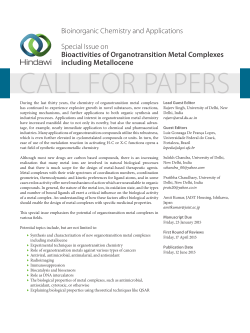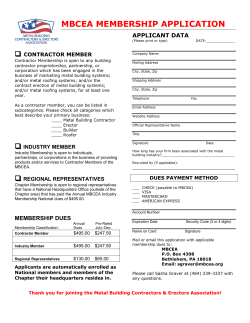
Fragmenting scrap metal
United States Patent ["1 3,603,515 [72] Inventors Gunther Lohmann 97,103,104; 164/70, 117, 262, 286, 299-301, 270', 30/134; 18/DlGv 46 Eglsee; Alfons Gulninski, Amberg, both of, Germany [56] * [21 ] Appl. No. 803,352 [22] Filed [4S] Patented Feb. 28, 1969 Sept. 7, 1971 [7 3] Assignee Luitpoldbutte Aktiengesellschaft Amberg, Germany [32] Priority Mar. 1, 1968 [331 Germany [31 ] P 16 08 344.6 References Cited UNITED STATES PATENTS 2,043,328 6/1936 2,523,558 9/1950 Caval1ier.... Mosshart ..................... .. 241/236 X 3,101,045 8/1963 Endert ............ .......... .. 241/266 X 3,284,896 1 1/1966 Reichbom-Kjennerud ,. 30/134 164/300 Primary Examiner—D0nald G. Kelly Attorney-Hammond & Littell [54] FRAGMENTING SCRAP METAL 6 Claims, 2 Drawing Figs. ABSTRACT: Fragmenting elongated pieces of scrap metal by [52] U.S.Cl .............................. ...................... .. 241/100, [51] Int. Cl ............................................. ........ ..B02c 18/00, [50] FieldotSearch .......................................... .. 164/270, 164/286, 241/101, 241/266 B02c 13/00, B02c 19/12 241/30, 100,101, 190, 236, 264-9, DIG. 22, 19,9; 225/1 , means of multiple number of arms operating in scissorlike fashion. The fragmenting apparatus is mounted on the framework of a centrifugal casting machine and acts periodi cally to break accumulated strips of scrap metal dumped from the casting machine running channel onto the framework. The fragmented pieces then fall to a collection trough from which they are subsequently removed for remelting. I l l l I, I l I 1I ia \\\\\\\\\\\\\\\\\\\\\\ \\ \ \ @mmm PATENTED SEP 7 I971 M w III Quinn IINVENTOR GUNTHER LOH ANN ALF-‘OMS GUMINSKI BY 52 m ATTORNEW 3,603,515 2 FRAGMENTING SCRAP METAL BACKGROU ND OF TH E INVENTION I2 and rails 18, 20 are laid on the l-beams. The centrifugal pipe casting machine rides on rails 18, 20 to and from a ladle. Between l-beams l4, I6 is mounted a pair of shafts 22, 24 which are securely attached to the framework or the ?oor by In centrifugal casting machines for casting pipe, a tilting la means such as roller bearings 26. A plurality of spaced frag dle, holding slightly more metal than is required to form one pipe, is ?xed at the head of each machine. This ladle may be menting arms 28 are rigidly mounted on each shaft in spaced tilted at a predetermined speed and the metal made to ?ow at a given rate down a fall spout into a long runner channel which projects into the mold. The rate of movement of the centrifu which cause rotation of the shafts in unison in opposite directions. Secured to the framework, as illustrated in FIG. 2, gal casting machine away from the ladle is adjusted in relation to the rotation of the mold in order to obtain a pipe of desired thickness. In centrifugal casting processes, such as the Laveaux process, the runner channel is at least as long as the pipe that is manufactured. Even when the metal is maintained at an op timum constant molding temperature, a residue of the metal relationship. Each shaft also carries meshing gears 30, 32 is a double-acting cylinder 34 adapted for actuating one of the shafts. Since the shafts are coupled to each other through meshing gears 30, 32, actuation of one of the shafts will trans mit the impulse through the gears to the other shaft and cause it to rotate in the opposite direction. Operation of the herein described apparatus is self-evident from the drawings. The scrap metal is deposited on the framework or the bed structure shown in elevation in FIG. 1. remains at the bottom along the entire length of the channel. Since the scrap metal is in the form of elongated members, This metal hardens into an elongated strip which must be 20 they remain disposed on the framework. When a quantity of removed before commencing the succeeding molding the scrap metal has been accumulated, cylinder 34 is actuated sequence by means of scraping or impacting. to rotate the shafts in opposite directions. As the shafts are In order to avoid the necessity for removing the scrap metal caused to rotate, arms 28 are also caused to rotate and to strips by scraping or impacting means, it is customary to tilt sweep the scrap metal into the zone located between the ad the running channel and dispose of the scrap metal strips onto 25 vancing arms. As this action continues, the scrap metal is com the machine bed which consists of longitudinal frame mem pressed gradually until the point where it fractures into bers supporting the rails on which the molding machines ride, smaller fragments. If these fragments are small enough, they and transversely disposed bulkheads for reinforcing the bed fall through the framework and into trough 36. The shafts are structure. The problem herein resides in the fact that the scrap rotated until the arms are in the position shown in dotted lines metal strips are so long that they cannot fall between the bulk in FIG. 2. At this point, all the scrap metal has been crushed or heads. As additional scrap metal strips are disposed of onto fragmented into small pieces which have fallen into the trough the bed, the strips rapidly accumulate to the point where 36. When the scrap metal on the framework has been disposed of, the cylinder 34 is again actuated to rotate the shafts in op posite directions and thus to retract the arms into inoperative unexploited production time and facilities and consequently, 35 condition. To crush scrap metal, which may have become in terms of diminished productivity of the manufacturing wedged in the apparatus, it may be desirable to repeat the plant. operation described above to rid the framework of the scrap metal. This sequence of steps is repeated over and over again OBJECTS OF THE INVENTION 40 with each accumulation of the scrap iron on the framework. It is an object of this invention to increase productivity of a We claim: manufacture of the pipes must be interrupted in order to remove the scrap metal. This interruption is costly in terms of centrifugal pipe casting operation by providing for automatic and efficient removal of scrap metal from the bed structure of ll. Apparatus for fragmenting elongated strips of scrap metal disposed on the framework of a centrifugal pipe casting the casting machines. machine comprising a plurality of fragmenting means com It is another object of this invention to provide apparatus for 45 prising a plurality of spaced arms rigidly affixed to a pair of fracturing and crushing the scrap metal which falls onto the shafts positioned on said framework and mounted in a spaced bed foundation of the casting machine. relationship on the said framework and activating means for It is still another object of this invention to provide ap effecting operation of said fragmenting means to cause frag paratus for clearing the bed structure of a centrifugal casting 50 mentation of elongated strips of scrap metal disposed on the machine of scrap metal during break periods. framework. A further object of the invention is the provision of ap 2. Apparatus of claim ll including meshing gears on each of paratus for fragmenting scrap metal wherein the scrap metal is said shafts; said actuating means comprising a double-action subsequently remelted without any further crushing or frag cylinder operatively secured to one of said shafts whereby ac mentation. 55 tuation of said one shaft causes actuation of the other shaft THE INVENTION through said meshing gears. 3. Apparatus for fragmenting and crushing strips of scrap This invention relates to apparatus for crushing or frag metal disposed on the framework of a centrifugal pipe casting menting scrap metal strips deposited on the bed structure or framework of a centrifugal casting machine. The scrap metal 60 machine comprising a pair of shafts disposed lengthwise in spaced relationship on said framework; means rigidly and is fragmented by means of a plurality of spaced arms which are rotatably securing said shafts in place; a plurality of spaced actuated in the same or in opposite directions. The arms are mounted on one or separate shafts which are provided with arms rigidly mounted on each of said shafts; a gear provided on each of said shafts, said gears being in mesh and coupled in gears. These gears mesh and are actuated by a single drive means. The action of the fragmenting arms in breaking up the 65 operative relationship; and actuating means operatively con nected to one of said shafts whereby, upon actuation, said scrap metal strips is analogous to the action of scissors when shafts are caused to rotate in opposite directions which, in cutting. turn, causes said arms to rotate in opposite directions and to For a more speci?c description of the invention, reference crush said scrap metal in scissorlike manner whereby said is made to the drawings, wherein scrap metal falls through said framework. FIG. 1 is the elevation view of the framework which sup ports the centrifugal pipe casting machine; and FIG. 2 is a view ofasection of FIG. ii. The apparatus of the present invention consists of a 4. Apparatus of claim 3 wherein said arms on said shafts are mounted in pairs, one on each shaft, in offset relationship. Apparatus of claim 4 wherein said actuating means is a framework which supports the centrifugal pipe casting double-acting cylinder. machine. The framework is de?ned by transverse bulkheads 75 "aApp'aratus of claim 5 including a trough means below said 12 which are positioned in alignment in spaced relationship. A framework for collecting said fragmented strips of scrap nair Of I-beams 14. 16 are disnnsed on the sides nf l'mllrhearlc mnatql
© Copyright 2025









